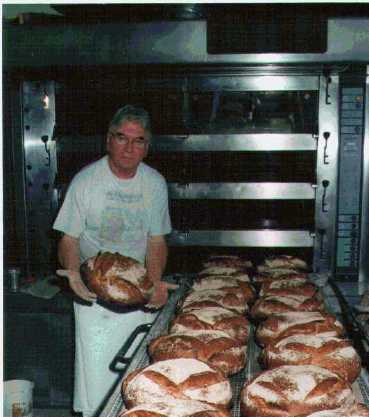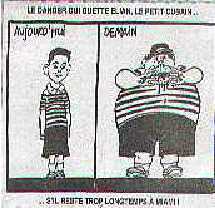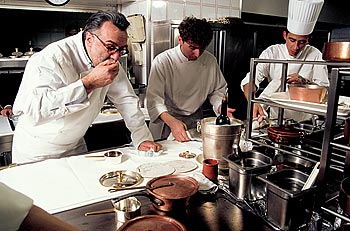|
| Tips
on food and cooking (#1) |
And also :
|
|
|
|
 Photo: "Bio" bread baker Michel
Moisan in his shop in the 14th arrondissement. Try the pain au
basilic! Photo: "Bio" bread baker Michel
Moisan in his shop in the 14th arrondissement. Try the pain au
basilic! |
| Five secrets of the French
diet ... |
|
Have
you ever tasted ....? |
|
Americans
are always amazed that the French "eat so much and remain
so slim ". How do they manage? Is there a French mystery
? What is the secret of the French woman
? Read Lithe!
Slender! French! about the best selling book, "French
Women Don't Get Fat".
-
No eating between meals (no snacks!) : don't eat when you're hungry, eat
when it's time to eat. With regular meal hours, you're never
hungry ! French parents tell their children that only animals
are hungry...
-
Complete meals (several courses)
with small portions.
-
Food bought fresh from
the market : Although the French shop in supermarkets or "hypermarkets",
they also enjoy a once or twice a week outing to outdoor markets
for fresh fish, fruit, vegetables. Bread is not bought for the
day - fresh baguettes are purchased meal by meal.
-
Lots of vegetables and olive oil.
-
No guilt!! Chic French women watch their weight like hawks
but when they go out to dinner or a party, they're ready to celebrate.
Champagne? A piece of delicious "tarte aux fraises"
(strawberry tart)? Of course! Even if our French person is "on
a diet", he or she won't say it. After all, a party is a
party! The pleasure the French take in the conviviality of food
is one of their most endearing qualities and quite probably keeps
them slim as well!
The result : the % of obese
people is 7,4% in France, compared to 39,1% in the USA (but
it is growing....) See comparative
figures and read my column about "the ugly American eater".
If you liked "French Women Don't
Get Fat", you'll love French Fried,
Harriet Welty Rochefort's tale of how she learned the French
secret for staying slim while enjoying the thinking about, shopping
for, preparation of, and savoring of sitdown meals, whether for
family or for company, informal or formal. French Fried
explores Harriet's forays into the MINDS of the French and the
way they think about food. Conclusion: for the French, food is
a delight and there's nothing that can beat assembling a meal
and pairing food and wine.
For more on the French and their healthy, sane attitude toward
food, read "French Fried" which the only nine-star
chef of France, Alain Ducasse, called a "lively, hilarious,
and insightful" book.
|
|
-
Fruits : the mirabelle is a delicious small yellow plum, which
grows mostly in the region of Lorraine ; the season is very short
(two or three weeks, late August) : not to be missed!
-
Cheeses : do you know Gaperon ? It is a
tasty slightly-garlic-flavored cheese from the mountainous region
of Auvergne in the center of France. It is pasteurized, so you
might be able to find it in the States or, at least, bring it
back home.... And what about Cancoillotte ? It is a very soft, buttery liquid
cheese from the East of France that you spread on bread.
-
Less well-known vegetables : you can
find them everywhere and they are delicious ; among them, salsifis
(oyster plant, purple goatsbeard), topinambour (Jerusalem artichoke), bette
(garden beet, chard), etc...
-
Beverages :you haved tasted
Cognac (brandy), but do you know Armagnac ? Coming from
a region called "Gers", it is a wonderful brandy, different
from cognac (which tastes a little drier). Floc (armagnac mixed with wine) is a delicious
before-dinner drink, as is its equivalent in the cognac region,
pineau des Charentes, or in Burgundy, Ratafia.
-
The huge variety of saussages, hot or cold : hot like merguez (small, 2/3 beef + 1/3 lamb + quite spicy, comes from Algeria and is one of the most popular) or andouillette, or cold like andouille (sort of a much bigger cold andouillette).
-
Always try regional
delicacies such as Crème de cassis (creamy alcohol
from black currant) in Burgundy, piment d'Espelette (sweet
red pepper) in Basque country, poiré (cider made
of pears) in Normandy, huile de noix (chestnut oil) in
Quercy, etc...
-
More to come..
USEFUL TIP
ON ...... TIPS : in France, in restaurants, cafés, etc...,
the TIP IS ALWAYS INCLUDED. You may leave a little something
(the yellow coins in a café, 1 or 2 Euros in a restaurant,
more in a very fancy restaurant) but you do not have to and nobody
is expecting it.
DID YOU KNOW
THAT ...? In France coffee is not served with dessert.
It is a separate course and will come after it, even if you are
very specific when ordering. That's a French custom !
|
|
 Drawing by Cabu, in Le Canard Enchaine April 19,
2000 about little Elian Gonzales ("Today/Tomorrow : The
danger for the little Cuban if he stays in Miami too long") Drawing by Cabu, in Le Canard Enchaine April 19,
2000 about little Elian Gonzales ("Today/Tomorrow : The
danger for the little Cuban if he stays in Miami too long")
Why don't you just enjoy it?
-
One secret of French cooking : Don't follow a recipe ! Most French chefs rely on smell, feel
and taste and don't worry about the exact quantities. After all,
they're in a kitchen and not a pharmaceutical company! The exception
to this is pastry where temperature, quantities and ingredients
have to be extremely precise. Click here
for more information about the metric system
-
When outside Paris, always choose the local speciality. It includes local products and know-how and it is always better than elsewhere. For example : bouillabaisse (fish, in Marseille), cassoulet (beans, in Toulouse), choucroute (sauerkraut, in Alsace), mussels with cream (Normandy), quenelles (fish, in Lyon), etc...
-
Don't be obsessed by chefs, recipes, newspaper articles, etc... : just enjoy what you eat and drink ! (remember that in 2009, the movie "Julie and Julia" was one of the biggest flops in the history of cinema : nobody in France knows the name of Julia Child !). Read about pleasure...
-
Why are the French (and particularly French women ) so slim? The answer "They have a croissant in the morning
and they smoke the rest of the day" is funny but wrong...
-
Don't pretend you're "allergic" to something, unless you've been declared allergic after serious medical tests. Be frank and say you don't like it or you don't want to try it...
-
Read Harriet's book "Joie de Vivre" to understand why the French have such good food !
-
Best-selling cookbook author and lover of Paris, Betty Rosbottom has cooked and eaten her way around the City of Light : visit her site for restaurant tips and much more.
-
More to come.....
|
|
France in a nutshell!
Gastronomy in kindergarten and primary school ... In case you are wondering why food is so important to the French and how they manage to maintain this tradition, look at this document : it is the menu, day by day of a school in Paris (kindergarden and Primary : 3 to 10 years old kids). Five-course meals, changing everyday, with the reference to quality ("homemade", "organic", "regional produce", etc). Not twice the same dish for each of the 5 courses on a period of a month or so. Not much sugar, lots of fruits and vegetables, zero soft drinks : a very healthy diet. The price is very reasonable for the parents (almost zero to 7 Euros/day, according to the family income, average = 3.50 Euros). The idea is to give to the kids an education of variety and quality, even with simple dishes. A few more details :
- you can see that there is nothing sophisticated but nothing banal either : traditional sauces, nothing fried, nothing straight from the can, ... ; even the kind of bread changes every day
- there is an option for children who do not eat pork
- to help the mothers : every day, a menu is suggested for the dinner of the family (this is to educate the parents!)
- more details on the site of the Caisse des Ecoles (something like : the school board)
- more to come . . .
DID YOU KNOW THAT......
? The story of Parmentier and the history of the potato
in France : Antoine Parmentier (1737-1813) is famous for having
contributed to the introduction of the potato in France. The
French are very conservative and it was difficult to convince
people to plant and eat this new vegetable ; he succeeded by
using two tricks which illustrate a profound understanding of
the French character:
- Snobbism : Parmentier convinced King Louis XVI to wear a potato
flower on his jacket : nobles of the court immediately thought
the potato was a fashionable plant
- Lack of civic sense : Parmentier had a field of potatoes guarded
by soldiers (instructed to be blind and do nothing) : people
immediately came and stole the potatoes.
That is the way to deal with the French !
 |
| An odious and chauvinistic joke ! |
|
| Tips on French food... |
|
Most repulsive French
food.... |
|
About wine ...
- Do not drink it too cold : never
chilled, no ice cubes ! Why? Kills the taste.
- Do not serve yourself (at formal
dinners)
- Do not believe that wine gives
headaches (unless you drink too much !)
: what give headaches are sulfites (i.e. : bad wine)
- Do not fill the glass more than
half
- Talk to people (who sell it
or who drink it with you) : they'll teach you a lot
- Remember that the "rules"
are flexible (for instance, certain white wines match perfectly
withe certain cheeses)
- More
about wine
About cheese ...
-
Do not cut too big pieces :
do not leave uneaten food in your plate. It means you did not
like it (and cheese is expensive!)
-
Cheese is a living entity :
eat raw milk cheese (and do not keep it too long)
-
It it traditional to offer cheese
only once and not propose a second helping
-
Talk to people (who sell it
or who eat it with you) : they'll teach you a lot
-
More about
cheese...
DID YOU KNOW THAT....? The French do NOT take it seriously when you say that your are allergic to something..... For them, it is just a pompous way to say that you don't like it or that you don't want to taste it. Allergies do exist, but they are considered a "real" illness and treated as such. I remember, once, when I was in an emergency ward with a young American student who had had plenty of Champagne and pretended she was allergic to Champagne. The doctors, could not believe it : for them she was just drunk, and they were absolutely right!
About bread ...
-
NEVER forget bread if you have
French guests!
-
Do not put bread ON your plate
: put it on the table.
-
Buy fresh bread once or twice a day.
-
You don't need to put butter
on the table
-
Remember there are many kinds
of bread.
-
More
DOs & DONTs...
Do you know why the State sets
the vacation dates
of your baker ?
|
|
Other than snails and frog
legs, if you want to experience the kind of food that the French
enjoy but which is most unusual for many Americans, try the following
:
-
Boudin
: a blood sausage, delicious
with mashed potatoes, spicy when " Antillais " (from
the French Carribean Islands)
-
Cervelle
(brains) : very delicate
(lamb or veal brains), with melted butter and capers : read a
funny letter
about it
| Civelles : baby-eels (one to two inches long),
eaten raw with a vinaigrette
(a delicacy in Nantes and Bordeaux) |
 credit credit |
-
Cheval
(horse meat) : very tender
and fat free, recommended for children and convalescents (some
butcher shops, called "boucheries chevalines" sell
only horse meat)
-
Huitres
(oysters) are eaten raw with
vinegar or lemon (yes, they're alive!)
-
Lapin
(rabbit) : fried or in a
stew, delicious when roasted with mustard
-
Os à moëlle : bone marrow (to eat with coarse salt)
-
Pied de cochon
: fried pig's foot (many
bones and nails to suck...)
-
Rognons
(kidneys) : fried, with a
mustard or a wine sauce
-
Steak tartare
: mashed raw beef meat, mixed
with sliced onions, egg yolk, parsley, spices,...
-
Testicles
(of billy goat or bull) :
very milky, fried or used in "bouchées-à-la-reine
" (a classical first course in banquets)
-
Tête de veau (veal head)
is a delicacy including everything (nose, cheeks, ...) served
with a vinaigrette or
mayonnaise
-
More generally, anything from
the interior of a pig (or a calf) : stomach, heart, intestine,
tongue, liver, kidney, sweetbreads, etc : called " les abats " (some shops, called "triperies
", sell only that)
-
More to come
|
DID YOU KNOW THAT....? The Foie Gras is
one of the most appreciated French delicacies and it is associated
with festive opportunities such as Christmas, New Year's Eve,
fancy dinners, elegant coktails. It is made of the liver of force-fed
geese or ducks. If you are offered "foie gras", never
call it "pâté" (it is much better and
much more expensive !). It was banned in April 2005 by the City
of Chicago (and by the State of California since 2004) in the
name of the defence of animals against cruel treatments. The
French thought that this was a very funny decision and that there
will be more foie gras left for them.
|
|
DID YOU KNOW
THAT... French eating habits and table etiquette are very particular
in France. For a humorous view of them, you may enjoy an article
by Harriet Welty Rochefort : "Don't Eat Your
Soup With a Fork -
And Other Conseils of French Politesse" !
USEFUL TIPS....
In France, people use much less ice cubes and it's an
absolute no-no to put ice cubes in wine, red or white, and in
champagne. Remember alos that a "limonade" is not like
US "lemonade". If you want a "lemonade" ask
for a "soda au citron" or you'll get either nothing
(because only children drink "limonade") or an extremely
sugarry and sticky beverage...
|
| The Chocolate War... |
|
Two
radically different defenders of French cuisine |
|
REAL chocolate is composed of
cocoa and cocoa butter - and no vegetable fats and traditionally
was the chocolate one bought in France. You can still find this
real chocolate in specialty shops and some supermarkets in France,
but buyers beware! Why? In March 2000 the European Parliament voted to permit
the addition of margarine and other oils into chocolate. The
burden is now on the buyer to read the label to see if the product
is the real thing. Which European countries started this movement
towards ersatz chocolate? England, followed by Ireland, Denmark,
Finland, Austria, Portugal and Sweden. Ah, the pitfalls of modern
Europe!
Conclusions :
1/ Down with globalization when it comes to quality food, and
2/ Never follow the eating habits of the English.
To enjoy REAL
chocolate :
- La Maison
du Chocolat
225 rue du Faubourg Saint Honoré 75008 & 52 rue François
Premier 75008
- Christian
Constant
37 rue d'Assas 75006
- For more on
this subject, read French
Fried
on the French and their food.
See the Raw-Milk-War
and the
Wood-Shaving-War.
How to read a (French)
label?
- French regulation is strict
on food products. More and more it is set by European rules.
- The most important thing to
check is the " date limite " (deadline) which is strictly
mandatory. Two wordings : " à consommer DE PREFERENCE
avant ... " means : best before .... (but no risk if you
eat or drink it after) but " à consommer JUSQU'AU
.... " means : it can be hazardous after this date.
- Other indications include :
" % de matière grasse ..." (i.e.% of fat), "
OGM " (i.e. Genetically Modified Organisms), "fermier
" (i.e. elaborated in a farm, no industrial process), "AOC"
(i.e. produced in a given region with a given high quality process),
etc...
- each of the word used to describe
the characteristics of the product must correspond to a specific
number or bracket and not a qualitative appréciation :
"faible teneur en.... " (I.e. low % of...), "
riche en ... " (i.e. high % of...), " sans ..."(i.e.
without...), " teneur réduite en ..." (i.e.
reduced % of .....)
- More to come.
A question about French chefs : when you see the picture of a French chef, he always has a striped collar blue-white-red. Why? Click here to know what it means!
Facts and figures about the French and food
- The French spend more than two hours (2:15) eating every day, about twice the time Americans devote to their beakfast, lunch and dinner (1:14). See detailed figures.
- In French, the word for "organic" is "bio" (beeho)
- More to come....
DID YOU KNOW
THAT. ? In France, obesity is much less frequent than
in the USA (see : Why French Women Don't
Get Fat ?)
but it is progressing. Measuring obesity by " Indice de
Masse Corporelle " = Weight (in kilos) / square of Height
(in meters) if larger than 30, the percentage of obese people
in the total population varied in France from 7 or 8 % in 1980
to 12 or 13% in 2005, when in the USA, for the same period, it
varied from 18 to 19% in 1980 to 42 to 44% in 2005.
DID YOU KNOW
THAT ? In France there is a doctoral program called " the
Harvard of Taste " : at the university of Reims, the
" Institut des hautes études du goût, de la
gastronomie et des arts de la table " (IHEGGAT, Institute
of Advanced Studies on Taste, Gastronomy and Arts of the Table)
offers courses at a pre-Ph.d level with the help of prestigious
chefs like Alain Ducasse and the best experts from Champagne
and Cognac companies.
DID YOU KNOW
THAT....? In spite of Jose Bové's demonstration, France
is the most successful and profitable country for McDonalds
! Not only that, but the French are making their McDonalds French
by redecorating the interiors in French style and adding courses
!
|
|
José Bové
 (Photo: Simon/AFP- Le Point) (Photo: Simon/AFP- Le Point) |
His claim
to fame in France : With nine other members of the Confédération
Paysanne, Bové a sheep farmer and political activist,
dismantled a McDonalds under construction in the small town of
Millau in southwest France, an act for which he served one month
of prison in preventive detention and was brought to trial. The
trial, with more than 40,000 supporters from three continents,
turned into Woodstock - sur - Tarn. Bové announced that
the anniversary of the trial would become an annual meeting for
healthy and traditional food and against high productivity in
agriculture. In June 2003, José Bové was emprisoned
to serve an 8-month term. He is very active against GMO and he
ran for president of France in 2007 (he got a pretty meager score
!). |
| José
Bové is the
controversial French hero of anti-globalization. In August 1999
this mustachioed pipe-smoking English-speaking leader of the
Confedération Paysanne and one of the leaders of the demonstrations
in Seattle against the World Trade Organization became a national
hero. He is now a very active member ofthe European Parliament.. |
This modern day Astérix,
the fisty Gaul of comic strip fame who fights the Romans, speaks
good English and likes America and Americans but not the "Americanization"
of European societies. (See "exception
culturelle".)
Harriet Welty Rochefort, along
with José Bové and Chicago chef Charlie Trotter,
spoke at a conference on "Taste, Technology and Terroir"
which took place at the University of Wisconsin in Madison, Wisconsin
on September 8, 2000.
|
Alain Ducasse
The only chef in
France to hold a coveted fourteen stars from the Michelin Guide,
Ducasse has 21 establishments in Monaco, Paris, and the U.S.
and has inspired "Spoon" restaurants in Paris, Mauritius,
London, and Tokyo.  |
In addition to contributing
to and writing cookbooks, the latest being "Le Grande Livre
de Cuisine" Ducasse is the president of the prestigious
"Chateaux & Hôtels de France" chain and has
a training center for chefs outside Paris. He also has a training
center for young chefs and each Sunday presents a new chef to
the French public in the "Journal du Dimanche". |
| Born on a
farm in Castelsarrazin in the Landes region of southern France,
French chef and businessman Alain
Ducasse is as outward looking as José Bové
is inward: while Bové was striking out at McDonalds in
France, Ducasse was busily increasing his fame and empire. Starting
at age 16, this tireless worker for whom the phrase "impossible
n'est pas français" was tailormade, worked for the
great French chefs Roger Vergé and Alain Chapel. At the
tender age of 33, he was Head of Cuisine and Chief Manager of
the Louis XV restaurant in Monte-Carlo which was awarded three
stars in the Red Guide. From then on, he has gone from success
to success. |
Ducasse occasionally
- and generously - endorses books about food. Here's what he
wrote about Harriet Welty Rochefort's book, French Fried: "In
a lively and hilarious style, French Fried gives an inside look
at the world of French cuisine and wine. This insightful book
reminds us that beyond cultural differences, it is important
to keep an open mind when it comes to food." |
USEFUL TIP.....
When is it best to eat oysters ? Answer : if the name
of the month includes an "r", i.e. not in Mai, Juin,
Juillet and Aout (all the other months include one "r")
! In Summer, oysters are perfectly edible but they are fat and
greasy. |
|
To related pages : more
tips on food (#2), French recipes, American kids in French restaurants, etc... |
|
To table
of contents
To top of the
page
Back to home
page
|
Harriet Welty
Rochefort writes articles and books about France and the French.
Order her books :
- "Joie de Vivre", Secrets of Wining, Dining and Romancing like the French, St.Martin's Press, New York, 2012
- "French Toast, An American in Paris
Celebrates The Maddening Mysteries of the French", St.Martin's Press,
New York, 1999
- "French Fried, The Culinary Capers
of An American in Paris", St.Martin's Press, New York, 2001
More on Harriet's
books
(excerpts, upcoming events, testimonials, etc..)
|
To Wine & Cheese Tastings in Paris with a talk on intercultural
differences by Harriet Welty |
| To email
me |
If you like
this site, please bookmark it or create a link!
|
|